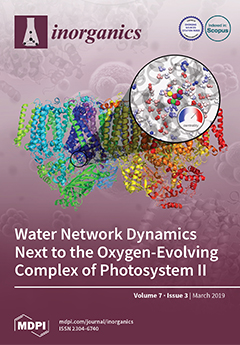Geometries, equilibrium dissociation energies (
De), intermolecular stretching, and quadratic force constants (
kσ) determined by ab initio calculations conducted at the CCSD(T)/aug-cc-pVTZ level of theory, with
De obtained by using the complete basis set (CBS) extrapolation [CCSD(T)/CBS
[...] Read more.
Geometries, equilibrium dissociation energies (
De), intermolecular stretching, and quadratic force constants (
kσ) determined by ab initio calculations conducted at the CCSD(T)/aug-cc-pVTZ level of theory, with
De obtained by using the complete basis set (CBS) extrapolation [CCSD(T)/CBS energy], are presented for the B···BeR
2 and B···MgR
2 complexes, where B is one of the following Lewis bases: CO, H
2S, PH
3, HCN, H
2O or NH
3, and R is H, F or CH
3. The BeR
2 and MgR
2 precursor molecules were shown to be linear and non-dipolar. The non-covalent intermolecular bond in the B···BeR
2 complexes is shown to result from the interaction of the electrophilic band around the Be atom of BeR
2 (as indicated by the molecular electrostatic potential surface) with non-bonding electron pairs of the base, B, and may be described as a beryllium bond by analogy with complexes such as B···CO
2, which contain a tetrel bond. The conclusions for the B···MgR
2 series are similar and a magnesium bond can be correspondingly invoked. The geometries established for B···BeR
2 and B···MgR
2 can be rationalized by a simple rule previously enunciated for tetrel-bonded complexes of the type B···CO
2. It is also shown that the dissociation energy,
De, is directly proportional to the force constant,
kσ, in each B···MR
2 series, but with a constant of proportionality different from that established for many hydrogen-bonded B···HX complexes and halogen-bonded B···XY complexes. The values of the electrophilicity,
EA, determined from the
De for B···BeR
2 complexes for the individual Lewis acids, A, reveal the order A = BeF
2 > BeH
2 > Be(CH
3)
2—a result that is consistent with the −I and +I effects of F and CH
3 relative to H. The conclusions for the MgR
2 series are similar but, for a given R, they have smaller electrophilicities than those of the BeR
2 series. A definition of alkaline-earth non-covalent bonds is presented.
Full article





